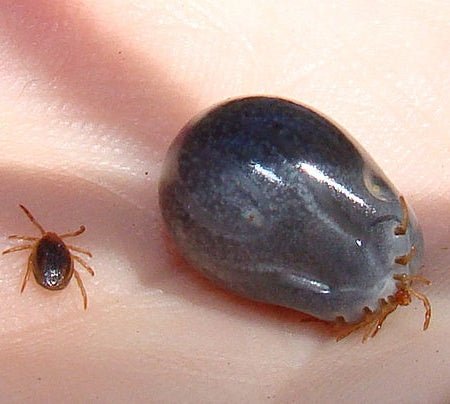Tick Season 🤢

We’ve been wishing for a little sunshine, a few less puddles and the option to walk without getting mud splattered on every outing. Our sunshine wish seems to be granted, well for a few days at least so that moves us on to the next challenge, Tick season 🤢

Mostly active in warmer months ticks are commonly found in long grass, woodlands, undergrowth, and areas with lots of wildlife. These little parasites feed on animal and human blood, they may also transmit diseases such as Lyme disease.
Ticks don’t fly or jump, they’re usually collected as an unwanted passenger when your dog brushes past them on grass, they crawl up their coat and attach to the skin to feed. These grim little creatures start off about the size of a pin head so are quite hard to spot, as they feed they can grow to about the size of a pea. If you exercise your dog in what could be considered a high-risk area, woodlands, long grass, or if your dog regularly collects ticks it is advisable to invest in a tick (and flea) repellent collar for the warmer weather.
The colour and presentation of ticks differs a little depending on the type and how full it is but bluish grey to pink, purple and brown are often seen. They can attach anywhere but can often be found around ears, arm pits and anywhere else really. Initially when you feel a tick on your dog or cat it is easy to assume it’s a lump or skin tag, when you look closely at your pet’s skin you’ll notice little legs wiggling behind the lump.
Some ticks in the UK carry and transmit Lyme disease (Borreliosis), speak to your vet if you think your dog has become poorly after having one removed.
Just to make things worse ticks can bite people too. they don’t survive for long on humans, but they can still attach and feed. As well as causing irritation and possible infection, ticks can transmit diseases such as Lyme disease (Borreliosis) to humans. Although Lyme disease is rare, if you find a tick on yourself or develop a ‘bullseye’ style rash, it is best to contact your healthcare provider for advice. If you know you’re going to be walking in long grass wear long trousers, especially if it’s in an area your dog has previously collected a tick.
Should you find a tick on your dog it’s important to remove it quickly and effectively ensuring the mouth parts come clear. There are some great tools for this which can be found online. Don’t try to squeeze, pull, or burn them off and don’t cover them in petroleum jelly.
Check your dog regularly, running your hands up their legs, checking arm pits, behind ears and tummies too. Just another reason as if we need one, to give them lots of love and attention.
-
Posted in
dog itchy skin, dog parasites, Health, Safety










